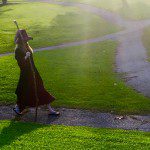A Pagan Almanac for July 27 and 28, 2012
Lunar Cycle: Ninth and tenth days of the waxing Moon
Rome: July 27, sacred to Castor and Pollux
Athens: Hekatombaion 9 and 10
Martyred on this day in:
1691, Ursula Gruenin,
1716, Isobel McKenley,
Elspeth Reid, and
Janet Toyes of Dining;
Janet Airth in Pothill of Aberuthven;
Helen Ilson and
Margaret Crose of Fontevio;
Janet Martin of Nether Gask;
Janet Young of Clathemore
They died in our name. Let us remember theirs.
William Blake wrote:
Art can never exist without naked beauty displayed.
________________________________________
In 1979, I was still not satisfied with my conclusions. There were still other missing pieces, which I did not expect to be able to find—until, again, they fell into my lap. For example, in 1979 I received a letter from Margot Adler on the envelope of which she scrawled an excited note that Doreen Valiente, in her latest book, had stated that Gardner had initiated her in 1953—and a missing piece of the puzzle fell into place. Doreen also said that in 1954-1955 she had co-authored the verse that begins “Darksome night and shining moon” and other materials used in the Book of Shadows. Since I knew from independent evidence that someone had been helping Gardner write, her claims seemed not only plausible but probable. Until then, no one in America had understood the importance of Doreen’s work on the Craft; but obviously, if she had begun working with Gardner in 1953, she could have helped get that final manuscript of Witchcraft Today into shape (later she told me that Dolores North–Madeleine Montalban–had done the typing and proofreading). Even more importantly, hers was almost surely the competent hand that I had detected alongside Gardner’s helping write the Weschcke documents.
Late in 1981, I had the pleasure of a visit from Fred Lamond, who was willing to answer many questions I had not thought I would ever get answered. He was still a member of Gardner’s original coven, into which he was initiated in January 1957 by Gardner and Lois Bourne, who has since then identified herself as being the Maiden of the coven at that time; Doreen Valiente was still, he said, the High Priestess of the coven, but was not there that night. One reason I knew his statements were accurate is that he knew the names—which I knew from reading the letters in Toronto—of the utterly obscure people who had been members of the coven in 1957. It was a great pleasure to ask him “Who was Ned?” and be told, “Oh, he was someone in the City,” which, of course, is British for “rich and well-connected.”
The very next month, in February 1957, Fred told me, the coven split in half; Doreen and Ned, as her High Priest, took four or five others with them to form a new coven. Fred said those left in the original coven soon decided to use the circle dance, rather than scourging, as their major way to raise power; so Gardner then wandered off to begin initiating new members for another coven more to his liking.
This was the situation when the “Craft Laws” were created; Robert thought they were the work of Doreen’s coven, since they had never been part of the original coven’s tradition. He also assured me that all the English Gardnerians of his time knew that Doreen had written virtually everything in the Book of Shadows, and that the master copy of that book was still in her possession. Fred believed there had been a pre-1939 coven, and said he knew several people who had met “Dafo,” who had also been a member of it. However, he admitted, she had never been forthcoming with any data about that coven.
“Wasn’t ‘Dafo’ Doreen’s Craft name?” I asked.
Fred said, “No, hers was . . .”
“Ameth,” we said, almost together, as the light dawned. (And that explained the peculiar letter from Ameth to Dafo I had found!)
“So Dafo was Dorothy Clutterbuck,” I said.
“No, Dafo had been the Maiden of the old coven, and after Dorothy died, she became the High Priestess until Doreen took over,” Fred said.
In fact, as Philip Heselton’s WitchFather now makes clear, Dorothy had never been a member of the original coven. The founder and High Priestess was Dafo, now known to have been Edith Woodford-Grimes. Philip has demonstrated the existence of the group into which Gardner was initiated and listed its members. However, they may not have called themselves a coven, and they certainly were not a Gardnerian coven by current definitions. He has also identified another half dozen people, including Dorothy Clutterbuck, who were friends of the coven and supported it. I do recommend you read his book.
In about 1980 I wrote a paper that I then presented at the annual meeting of the American Academy of Religion, the major worldwide professional association for college religion teachers; at that time I had begun teaching at the University of San Francisco. It had the very academic title of “The Invention of Witchcraft: Uses of Documentary and Oral-Historical Data in Reconstructing the History of the Gardnerian Movement.” (Or something like that; I’m not going to look for my copy of it right now.) The paper was subsequently published in the late Marcello Truzzi’s Zetetic Scholar, in Christa Heiden Landon’s The Great Write, and in Chas and Mary Clifton’s Iron Mountain; because of the latter, I got to make friends with Doreen Valiente. (Someone—I think Chas—later asked me if that paper could be included in an anthology of writings about the Craft. “Oh, sure,” I said, and forgot about it. So my paper, quite outdated, became the lead article in the three-volume tome on Paganism published by Routledge and priced at $400. That’s inflation.)
When she had seen that issue of Iron Mountain, Doreen wrote a critique of it that Chas published. I wrote a long and skeptical response to it, which Chas edited down, making it sound more negative than I had intended. She wrote a quite indignant response to that, whereupon I sent her directly an apology and the full text of my letter. I also told her that the news of even her membership in the London coven had not made its way across the pond, and that I was probably now the only person in America who, now that I had all the facts, could prove that, out of all the original crowd, she was the only one who had always told the unvarnished truth, as far as she knew it. For example, Gardner had never shown her “Ye Bok of Ye Art Magickal” and had given her a tall tale about where the Book of Shadows came from. I emphasized my belief in her truthfulness because some members of the Kentucky Lineage had insulted her by accusing her of lying in her Rebirth of Witchcraft. They disliked her dispelling some of the nonsense about the origins of the Craft. Their mindset appeared to be much like that of Evangelicals who want to believe that Genesis is literal history and who therefore reject most of modern science.
After that, she and I were good friends. She sent me lots of information that I was able to incorporate into Crafting the Art of Magick, the popularization of my research that Llewellyn published in about 1991. (Remember, Carl had reluctantly turned down the original manuscript, even though I wrote it under contract to him, because it read like a dissertation, not what his market would tolerate. And looking back at it, yeah, it was badly written.) I kept the narrative structure of Crafting and reinstated the details of my research, including all of Gardner’s erratic spelling, in Inventing Witchcraft: A Case Study in the Creation of a New Religion, which Tom Clarke published at the urging of Melissa Seims.
I did not know until very late on that the blonde woman looking into camera in the frontispiece to Justine Glass’s Witchcraft, the Sixth Sense—and You was Doreen, since by that time she was working with Robert Cochrane, who was the “Magus” whom Glass discusses and who was the source of much of the stranger information in Paul Huson’s Mastering Witchcraft. In the interview that appeared in Fireheart in the early 1990s, Doreen referred to me as “my old friend Aidan Kelly.” I was touched by and grateful for that. It felt like I had, for once, done something right.















